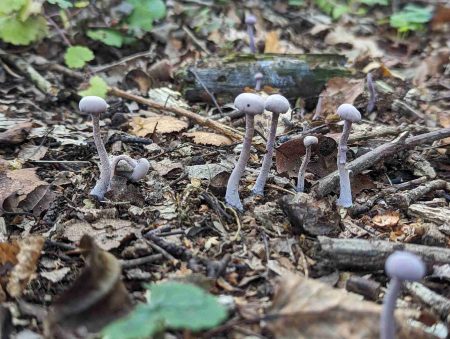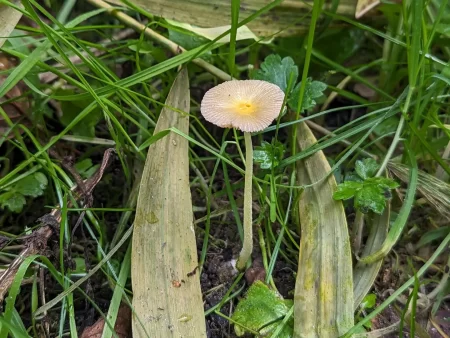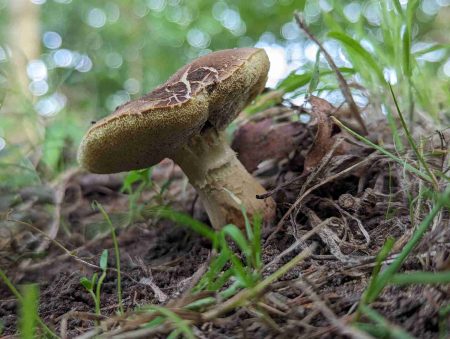Today was damp and foggy, but mild.
ENTRANCE AREA
On the Car Park path I saw a group of Coprinellus disseminatus covering some mossy wood, then I saw what looked like the remains of Coprinopsis atramentaria by a timber bollard.
In the entrance yard, the Agaricus had grown larger.
Under the bench on the path to Basecamp, I found a Bolete species (Fig. 10.0).
BASECAMP AREA
On the Basecamp Loop there was a large group of Laccaria laccata, and some blackened Tubifera ferruginosa (Fig. 10.1).
The slime mould on the path leading to Basecamp and the Dacrymyces stillatus were still there.
At Basecamp, the Scutellinia scutellata (Fig. 10.2) under one of the logs in the log circle had returned and there were a few remaining Candolleomyces candolleanus.
The Ramaria stricta had thinned and become darker, and on the same log I spotted another, smaller group growing as well as some other unidentified slime moulds (Fig. 10.3).
THE DELL
In The Dell, I spotted a singular Parasola conopilea in leaf litter, then a group of Artomyces pyxidatus on a mossy log (Fig. 10.4).
I saw a Xerocomellus species in the grassier areas, but the stem was too bitten to be bruised.
On a log I found a small group of purple fungi (Fig. 10.5), on a fallen branch a group of small Crepidotus (Fig. 10.6) and on the cut end of a log some reddish fungi (Fig. 10.7).
In between the twigs and branches of the branch circle I found the unidentified Bolete species from last year (Fig. 10.8).
A group of bright Lycogala epidendrum grew on one of the more rotted logs, and on the leaf litter grew a large group of Laccaria amethystina (Fig. 10.9).
Artomyces pyxidatus
The Dell

Figure 10.
Unidentified
The Dell

Figure 10.
Crepidotus species
The Dell

Figure 10.
Unidentified
The Dell

Figure 10.
Bolete species
The Dell

Figure 10.
Laccaria amethystina
The Dell

Figure 10.
SANDY GLADE AREA
Alongside the Arcyria denudata from last week, I spotted some new white forms — probably juvenile A. denudata.
The Hemitrichia clavata and Leucocoprinus brebissonii from last week remained the same.
On the Fen Trail Turnoff path, I found some Fuligo septica aethalia and a Cladonia species.
ENCLOSED AREA
I came across another group of Tubifera ferruginosa (Fig. 10.10) on a mossy log on the edge of the Alder carr alongside the path, as well as a singular Bolbitius titubans (Fig. 10.11).
Tubifera ferruginosa
Drainage Channel Path

Figure 10.
Bolbitius titubans
Drainage Channel Path

Figure 10.
In the Enclosed Area, I saw Tricholoma fulvum, Leota lubrica and Coprinellus micaceus.
I found another group of Clavulinopsis under a rotting log and a small orange milkcap — probably Lactarius tabidus (Fig. 10.12) — on the damp soil.
YEW GROVE AREA
On the path to the Yew Grove, I found more Fuligo septica and a white Stemonitis plasmodium (Fig. 10.13).
The Cyathus striatus was the same as last week, but around them, I noticed some other species: Amanita muscaria (Fig. 10.14), Clavulina cinerea (Fig. 10.15) and an unidentified pinkish Mycena (Fig. 10.16).
Just before The Outpost, the Pluteus aurantiorugosus from last week had turned a lighter orange.
Stemonitis species
Yew Grove Area

Figure 10.
Amanita muscaria
Yew Grove Area

Figure 10.
Clavulina cinerea
Yew Grove Area

Figure 10.
Mycena species
Yew Grove Area

Figure 10.
OUTPOST AREA
Nearby, on an Alder tree I found Inonotus radiatus (Fig. 10.17).
TRAIL END AREA
In the Trail End Area, on open leaf litter, I spotted some Russula parazurea (Fig. 10.18) and under branches and twigs I found an Amanita rubescens (Fig. 10.19).
Right of the path on an upturned stump, I came across a group of small Apioperdon pyriforme (Fig. 10.20) and more Parasola conopilea (Fig. 10.21) in the grassy sides of the path.
In one of the log piles, I noticed a Scleroderma verrucosum with a very large pseudostem (Fig. 10.22).
Russula parazurea
Trail End Area

Figure 10.
Amanita rubescens
Trail End Area

Figure 10.
Apioperdon pyriforme
Trail End Area

Figure 10.
Parasola conopilea
Trail End Area

Figure 10.
Scleroderma verrucosum
Trail End Area

Figure 10.
OTHER
Occasionally throughout the reserve woodland I spotted Coprinopsis lagopus and Russula ochruleuca.
The Hydnum repandum had reddened, but persisted.
There were a few different Fuligo septica, but less than in previous weeks.




